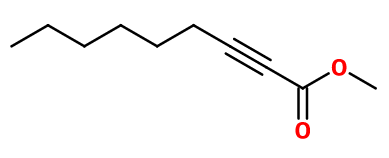
Photo credits: ScenTree SAS
Do you sell any of the raw materials? Would you like to let our users know?
Send an email to fournisseurs@scentree.coto learn about our advertising opportunities.
Do you sell any of the raw materials? Would you like to let our users know?
Send an email to fournisseurs@scentree.coto learn about our advertising opportunities.
General Presentation
-
CAS N° : 111-80-8
-
EINECS number : 203-909-2
-
FEMA number : 2726
-
Density : 0,921
-
Optical rotation : Donnée indisponible
-
Allergens : This ingredient does not contain any allergen.
-
Refractive Index @20°C : Donnée indisponible
-
Volatility : Heart
-
Price Range : €€€
-
Appearance : Colorless liquid
-
FLAVIS number : 09.156
-
JECFA number : 1356
Information on synthetic ingredients
-
Acid Value : Donnée indisponible
-
Boiling Point : 122°C (à 27 hPa)
-
Detection Threshold : Donnée indisponible.
-
Molecular formula : C10H16O2
-
Log P : 4
-
Molecular Weight : 168,24 g/mol
-
Fusion Point : Donnée indisponible.
-
Flash Point : 101°C
-
Vapor pressure : Donnée indisponible
Uses
Other comments :
In comparision to other green notes of Violet Leaf Absolute as Folione® or Violiff®, Methyl Octine Carbonate has a clear mushroom note.
Stability :
May form octine carbonic acid through time, under the effect of heat.
Unstable in acidic products, except antiperspirants, and very alkaline products
Uses in perfumery :
Methyl Octine Carbonate is used in notes of violet flower, tuberose, linden and mimosa. A green facet with fruity notes. Used in combination with green notes and ionones.
Year of discovery :
1903
Isomerism :
Jasmolactone is a constitutional isomer of Methyl Octine Carbonate. Its smell is however very different, as it is reminiscent of peach and jasmine.
Synthesis precursor :
Methyl Octine Carbonate is not a precursor to the synthesis of another compound of olfactory interest.
Natural availability :
Methyl Octine Carbonate is not available in its natural state.
Synthesis route :
Methyl Octine Carbonate is synthesized by an esterification reaction between non-2-ynoic acid and methanol. This reaction is catalysed by the presence of a strong concentrated acid such as sulfuric acid.
Regulations & IFRA
-
IFRA 51th : This ingredient is restricted by IFRA
-
Restriction type : RESTRICTION
-
Cause of restriction : DERMAL SENSITIZATION
-
Amendment : 49
- Quantitative limit on the use :
-
Cat.1 Cat.2 Cat.3 Cat.4 Cat.5A B C DCat.6 0,0018 % 0,00055 % 0,011 % 0,01 % 0,0026 % 0,0026 % 0,0026 % 0,0026 %0,0061 % Cat.5A B C DCat.6 0,0026 % 0,0026 % 0,0026 % 0,0026 %0,0061 % Cat.7A BCat.8 Cat.9 Cat.10A BCat.11A BCat.12 0,021 % 0,021 %0,0011 % 0,02 % 0,072 % 0,072 %0,04 % 0,04 %No Restriction Cat.10A BCat.11A BCat.12 0,072 % 0,072 %0,04 % 0,04 %No Restriction
Comments :
When used in the same fragrance compound within a specific QRA category, the sum total of and Methyl heptine carbonate (MHC, CAS number 111-12-6) and Methyl octine carbonate (MOC, CAS number 111-80-8) contributions must not exceed the maximum permitted level for MHC. At the same time, the contribution from MOC should always respect the maximum levels permitted as listed in the table above.

